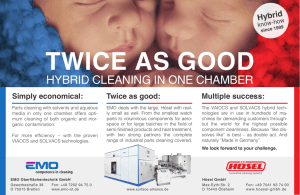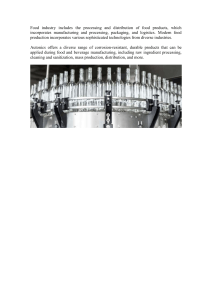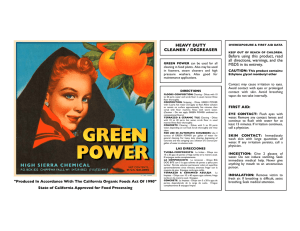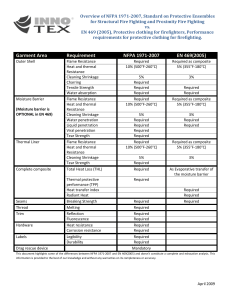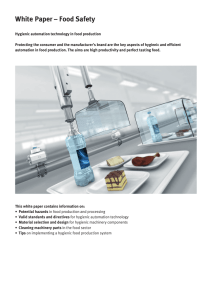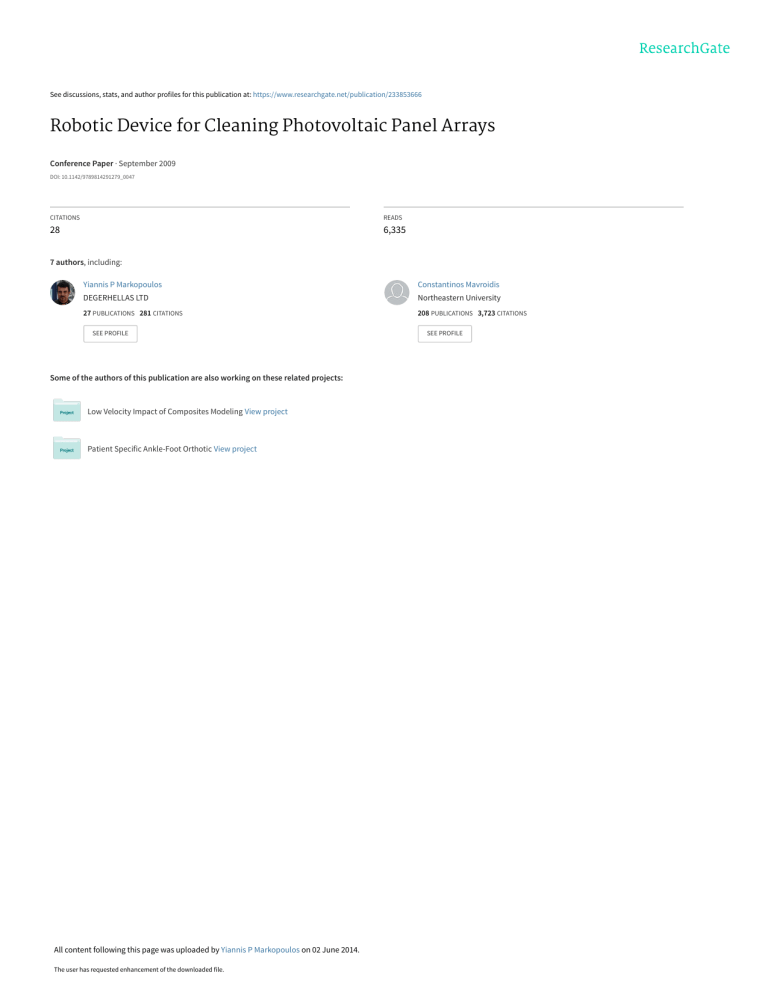
See discussions, stats, and author profiles for this publication at: https://www.researchgate.net/publication/233853666 Robotic Device for Cleaning Photovoltaic Panel Arrays Conference Paper · September 2009 DOI: 10.1142/9789814291279_0047 CITATIONS READS 28 6,335 7 authors, including: Yiannis P Markopoulos Constantinos Mavroidis DEGERHELLAS LTD Northeastern University 27 PUBLICATIONS 281 CITATIONS 208 PUBLICATIONS 3,723 CITATIONS SEE PROFILE Some of the authors of this publication are also working on these related projects: Low Velocity Impact of Composites Modeling View project Patient Specific Ankle-Foot Orthotic View project All content following this page was uploaded by Yiannis P Markopoulos on 02 June 2014. The user has requested enhancement of the downloaded file. SEE PROFILE ROBOTIC DEVICE FOR CLEANING PHOTOVOLTAIC PANEL ARRAYS MARK ANDERSON, ASHTON GRANDY, JEREMY HASTIE, ANDREW SWEEZEY, RICHARD RANKY, CONSTANTINOS MAVROIDIS* Department of Mechanical and Industrial Engineering, Northeastern University, 360 Huntington Avenue, Boston, MA, 02115 USA YIANNIS P. MARKOPOULOS** Green Project – Sustainable Technology and Energy Solutions Ippokratous 38-42 & Irakleitou, 152 38 Chalandri, Athens, Greece * Corresponding Author, [email protected], +1-617-373-4121 * Co-Corresponding Author, [email protected], +30-210-60.90.880 With growing costs of electricity and concern for the environmental impact of fossil fuels, implementation of eco-friendly energy sources like solar power are rising. The main method for harnessing solar power is with arrays made up of photovoltaic (PV) panels. Accumulation of dust and debris on even one panel in an array reduces their efficiency in energy generation considerably and emphasizes the need to keep the panels’ surface as clean as possible. Current labor-based cleaning methods for photovoltaic arrays are costly in time, water and energy usage and lack automation capabilities. In this paper a novel design is presented for the first ever human portable robotic cleaning system for photovoltaic panels, which can clean and maneuver on the glass surface of a PV array at varying angles from horizontal to vertical. 1. Introduction Photovoltaic array installations are becoming more prevalent around the world. Each of these solar parks has an expected lifetime of 20 – 25 years, and it is vital to maximize the power generating potential during daily service. The accumulation of dust particles and debris on the surface of photovoltaic (PV) panels negatively affects the performance the same way as if on a cloudy day. This is especially problematic in arid, dusty environments [1, 2]. There is a need for an automated cleaning solution to this problem which can service large ground based solar arrays up to an operating park of 22,000 panels (20,000 square meters). 1 2 An efficient robotic device can service such large scale parks for cleaning and built-in auto inspection for panels whilst conserving power and cleaning water when compared to human crews and current hardware alternatives. A photovoltaic cell is an Figure 1: Example of power output from a electronic device that converts photovoltaic cell installed at Northeastern solar energy into electricity by University., Boston, MA, USA. The graph shows substantial change in power output due to cloudy flow of electrons between two conditions which is equivalent to that obtained layers of semiconductors. In from dirt and debris on the cell's glass surface. order for the PV cells to operate at maximum efficiency without energy loss, the panels’ surfaces need to be clean and allow free entrance of photons. Both dirt and clouds block out the sun and have the same effect on reducing energy generated. Cloudy conditions block absorption and can reduce the effectiveness of the panels by 20% - 30% as seen in Figure 1. The graph shows the power output over the course of a week for a PV array at Northeastern University, Boston, MA, USA. Examining the curves for the first and fifth days they have significantly lower power outputs due to cloudy conditions. A controlled process should keep the panel surfaces clean to maximize output. Water for cleaning panels can also benefit efficiency because most crystalline silicone solar cells have better current-voltage characteristics at lower temperatures. The water being sprayed by the robot cools the panels while cleaning which can further increase efficiency of the array by up to 15% [3]. When the cleaning system is combined with auto-inspection features, the automated choice is clearly superior to traditional cleaning alternatives. The most important benefit of a robotized solution for the cleaning of photovoltaic panels is the increased speed, thoroughness, and repeatability with which the system will operate when compared with current methods. This paper presents the first robotized cleaning device for photovoltaic panels, the PVCleaner Robot V1.0. The main concept is shown schematically in Figure 2, composed of a cleaning head that moves over the panels while the robot’s auxiliary equipment for power and water supply is connected via umbilical, located on an adjacent support vehicle. The cleaning head is driven vertically by cables and horizontally by a pair of motorized drive trolleys which 3 ride along the top and bottom edges of the array panels. A modular design has been implemented to allow fast assembly / disassembly of the device, most notably that the two trolleys are identical except for the pulley motor. The drive and cleaning systems have been Figure 2: Concept of New Robotized Cleaner for designed to ensure Photovoltaic Panels. longevity of the device and array by not marking the glass surface with wheel skid marks and damaging micro scratches. To accommodate this constraint the cleaning head uses softer wheels (40 Shore) and the cleaning bristles are made of thin natural nylon (diameter 0.006 inch, 1.25 inches long). To avoid water spots and residue while the panel dries, the water line can be fitted to use de-ionized water, a common practice in hand cleaning of PV panels. 2. Background Despite the tremendous growth of the solar industry over the past several years, photovoltaic array cleaning and maintenance have remained relatively unchanged. Small scale arrays are still cleaned manually with a bucket and soap and water at a rate of 1m2/minute. Larger solar parks are hosed in batch by a fire truck in a water-intensive and non-specific cleaning process. A solar farm in Glendale, Arizona for example uses over 280 liters of water to clean a 5 square meter array [4]. Currently the most prevalent hand cleaning device for windows and solar panels is the tucker pole. This device is a hand nylon brush mounted to a pole outfitted with a water flow system and allows ten teams of two people to clean 10,000 panels in 8 hours. The most current automated cleaning system for small residential PV arrays that fit on homes or small office buildings is SolarWash [5]. The system is a static row of nozzles spaced incrementally along the top of a solar array and release a flow of cleaning solution when triggered by a micro-processor controller. The static nature of SolarWash limits the scale of implementation as a massive infrastructure is needed for the system to operate in commercial solar parks. This system still uses a high volume of water and the water flow is unable to cross the horizontal gaps between panel edges. 4 NASA uses photovoltaic technology to power many of its satellites, spacecraft, and extraterrestrial rovers but does not have a cleaning method in place for its extraterrestrial craft. The Mars rover in particular has to operate in harsh dusty climates. NASA has researched the decreased efficiency due to dust and buildup in relation to number of days on Mars. For a 30 day mission they account for 52.2% power loss, over 2 years they account for 89% power loss. NASA also recently announced that an unexpected Martian wind partially cleaned dust off of the Martian rover’s solar panels and significantly boosted the panels’ electrical output [6]. Cleaning a photovoltaic cell is similar to cleaning windows in large building so it is prudent to examine robotized window glass cleaning methods as well. A large number of such glass cleaning robots exist, the most famous being the RobuGLASS robot designed to clean the Louvre glass pyramid in Paris, France [7]. Thorough cleaning of glass panels can sometimes yield micro scratches which do not affect the functionality of a window, but scatter light entering a PV panel. Currently no robotic system exists to perform the cleaning of the glass surfaces of photovoltaic panels. 3. Design 3.1. Design Specifications A list of design specifications (Table 1) was compiled based on information from interviews with photovoltaic panel manufacturers and end users. The ranking weight of 5 is given to specifications with highest importance. 3.2. Overall Design of the PVCleaner Robot V1.0 The PVCleaner Robot V1.0 is composed of a cleaning head that moves across the panels by a pair of motorized trolleys which ride along the top and bottom panel edges of the array as shown schematically in Figure 3. This design was selected because of its modularity, simplicity, and expandability. It is easier to move the cleaning head around on the array while providing the lowest risk to scratching the panels by having the drive system rest of the frame rather than the glass. The expandability of this design allows acceptable continuous functionality on a wide range of array dimensions. Although not all panels or arrays are the same size, this system can adapt easily by interchanging belts depending on the number of panel rows. The panel columns have continuous travel since the robot can cross the side edges between the panel frames. 5 Table 1. Design Requirements for the PVCleaner Robot V1.0. Category General Cleaning Drive Environmental Efficiency Safety Control GUI Maintenance Requirements Weight Notes Dust Resistant 5 Can operate in dust and wind Heat Resistant 5 Can operate in up to 35°C Water Egress 5 Cleaning water spray will not harm device Novel Design Approach 4 Unique functionality and construction Portable by Two People 4 2 people can carry and set up Overall Weight 4 20-40 kg Inspection Capability 3 Allows expansion for auto inspection Water Resistant 2 No loss of function during light rain Cost 1 <$50,000 Free of Support Vehicle 1 Can operate with on board power/water Precision 5 No micro scratches generated Cleaning Speed 5 Faster than 1m^2 per minute Efficiency 4 At least 90% dirt removed Array Capacity 3 From 4 panels up to 280m 2 Cleaning Width 3 Between.5m and 2m Operation Angle 5 Operating surface up to 45° incline Gap Traverse 5 Traverse panel gaps up to 8cm Stability 5 Not tip from motion or wind Cleaning Travel Speed 4 Cover more than 1m / min 2 Traverse Panel Edges 3 Might slow down when crossing panels "Jog" Speed 2 Faster speed setting when not cleaning Water Consumption 5 Uses <40 L/hour fresh water Cleaning Solution Usage 4 <20% of water by volume Water Recycling 4 Capture & filter water Power Usage 3 <.5kw Noise Output 1 Under 80db Edge Identification 5 Stop before driving off an edge Safety Factors 5 Not fall if 50% of the drive system fails Safety Factors 5 Not fall under electrical problems Human Operation 5 Human remote override Autonomous 3 Requires no user input Detergent Refill 4 Operation <5 min Filter Cleaning 4 Operation <10 min Lubrication 3 Lubrication after 1,000 hrs., takes <30 min Consumables 3 Brushes last >200 hours Battery Life (no cord) 1 Battery power >1 hour, replace in <2 min 6 Figure 3: Schematic of PVCleaner Robot V1.0. 3.3. Drive System The drive system consists of three main components of motion. Both the top and bottom trolleys are motorized with a 12V DC motor (23.38 in-lbs at 179 rpm) to provide lateral motion to the system. The trolleys can be controlled independently of one another to follow a square-wave cleaning pattern along the panel rows. The top trolley also houses the cleaning head lift assembly seen in Figure 4. The lift motor is a Leeson 90V DC that drives the belt-pulley assembly to adjust the vertical position of the cleaning head on the array. The major challenge in the trolley design was maintaining a stable attachment to the array while still keeping low friction during travel. This was solved using a hand clamp carrier system riding on dynamic suspension, and can still cross gaps up to 8cm between panels. Equilibrium balancing between the motor and drive components ensure minimal moments on the panel frame during dynamic cleaning. Four inductive proximity sensors (Contrinex 500 M30) on the trolley frame detect the edge of the panel to slow the motion for crossing a gap, or stop the motion if reaching the array’s end. The carrier system utilizes four pivoting pairs of wheels which are clamped to the panel with user friendly knobs. These carriers, seen in Figure 5 LEFT, are what hold the trolley to the panels while allowing the safe crossing of gaps. The clamps are spring loaded to allow for consistent clamping pressure among the different carriers and simple disassembly. The wheels on the carrier 7 assemblies have a flat profile to allow for maximum contact area with the panel. This is intended to add support against dynamic moments during sideways motion, which if not balanced properly could torque the trolley off of the panel. Figure 4: Top Trolley Assembly. Figure 5: LEFT: Trolley Carrier Assembly; RIGHT Drive Wheel Pair. Four drive wheels are mounted on each trolley as assemblies of two pairs. Each pair is linked via chain, as seen in Figure 5.RIGHT, so that only the innermost two wheels need to be directly driven by the motor. The two pair design ensures that there will always be at least two drive wheels in contact with the edge when crossing gaps between panels. The motor placement and belt routing for the drive wheel system was carefully considered to locate the trolley center of mass as close to the edge of the panel as possible. These moments were also balanced with the cleaning head lift assembly and belt tensioners. 8 3.4. Cleaning Head The cleaning head actively cleans the panels while traveling upward and downward along the panel surface. This dual functionality is the primary advantage of this design. Two identical sprayer assemblies are mounted on the top and bottom of the cleaning head, followed by two brushes towards the middle of the assembly (see Figure 6). Along the centerline is a novel pivoting scraper design which trails the motion to dynamically divert used water away from the pre-cleaned surface and pre-wet the next panel at the same time. In order to ensure that the dirty solution runs off to the same side regardless of travel direction, the scraper has been located on a Figure 6: Exploded View of Cleaning Head. bracket that pivots. This scraper is mounted to a chassis which pivots about a central axis according to the desired direction of motion. Guide cables fastened to each drive trolley prevent unwanted rotation and lateral movement of the cleaning head. The sprayer assemblies are located along the horizontal perimeter, as seen in Figure 6. The sprayers are located in this position to minimize scratches when the brushes and debris are saturated with water and detergent solution. A solenoid valve (Omega SV3100) is used to direct the water supply to the leading edge only at a given moment and minimize waste water. This ensures that the cleaning path is well saturated while reducing the water consumption and eliminating water spots that may occur if the trailing sprayer were also active. To allow the design to be fed by only one cleaning solution hose it was necessary to locate the valve on board the cleaning head. Brush selection was optimized for efficient cleaning without damaging the panel surface from micro scratches. Considering application for the brush frame was for harsh environments and strength, the core was fabricated from Acrylonitrile Butadiene Styrene (ABS) plastic to reduce weight. An experiment was implemented to test three different bristle samples to determine if it would be possible for any of the bristles to scratch glass under a range of loading forces. Two diameters (0.003”, 0.006”) nylon and horse hair were examined under microscope for scratch prevalence. 9 To test the bristles for scratching, the pressure along the edge of the brush that contacts the panels was estimated according to the cleaning head weight and shear force from the brushes rotating. Using the CAD assembly files, the weight of the cleaning head that would be applied to the brushes was used over a surface area of 36in2. This pressure was then applied to the sample bristles saturated in water while scrubbing a glass slide. After the abrasion testing each glass slide was inspected under microscope to determine if any scratches were evident. None of the bristles caused any scratches on the slides, so the 0.006” nylon was selected based on secondary selection criteria for desired brush stiffness and bristle longevity. The intended cleaning head vertical direction is coupled with the desired brush rotation. There is no motor required for turning the brushes since these movements are coupled using Syncro-mesh wires. These wires have been utilized to act as the guide cables while also providing the torque to rotate the brushes as the cleaning head travels up and down. These cables have a spiral thread pattern which mates with gears along the cleaning head frame similar to a chain-sprocket system. The bristle pattern on the brush was carefully chosen to prevent any unwanted lateral motion from being caused by brush rotation. If the bristles were a spiral pattern, they would push the cleaning head laterally as they spun, so the bristle pattern is mounted as multiple parallel rows around the shaft instead of a spiral. The final cleaning operation is from the scraper trailing behind the leading brush, seen in Figure 6. The purpose of the scraper is to remove the soiled cleaning solution from the clean area of the panel leaving a clean dry surface. The design intent is to push any dirty liquid away from the sections of the array that have already been cleaned. Not only does this avoid requiring a second cleaning pass, but there is an added benefit of pre-soaking the next dirty section of the array. 4. Prototype and Initial Experiments The first prototype of the PVCleaner Robot V1.0 is shown in Figure 7. The trolley weights are 6kg and 18kg for the bottom and top trolleys respectively, while the cleaning head 10kg. The system overall weight met the desired specifications described in Table 1. The system can be assembled and installed in under 10 min by 2 people without any specialized tools. Initial cleaning test in Figure 7 showed one pass of cleaning at a rate of 2.33 m2/min using 0.58 L/m2. That is almost 100 times less water used than just spraying down the 10 panel with a hose. After a single pass of the cleaning head, a dirty panel is thoroughly cleaned as shown in Figure 8 where on a dirty panel it is easy to see the clean path left by a single pass of the cleaning head. It was successfully able to clean off sawdust, dirt, as well as dry and wet mud. Figure 7: Prototype of PVCleaner Robot V1.0 and Close Up Views of the Trolley Carrier and Cleaning Head. Figure 8: Dirty Panel after Single Pass with the PVCleaner Robot on the Left Side While the Right Side Stays Dirty for Comparison Purposes. 5. Conclusions With rising implementation of photovoltaic arrays, a new method of cleaning and inspection is necessary. Complete cleaning is especially important since the obstruction of a single panel with debris affects the energy generation for the entire array. It is extremely important that all cells operate at peak efficiency since they are connected in series. Advances in energy technology should be accompanied by advances for their support, maintenance and inspection devices. 11 This paper presented the first ever robotized system for cleaning photovoltaic panel arrays at large scale solar parks. The PVCleaner Robot V1.0 is composed of two motorized trolleys (which provide horizontal motion) and a cleaning head driven by a belt and pulley system (for vertical motion). The cleaning head is designed to clean while traveling both upwards and downward. It is made up of two sets of sprayers to apply the cleaning solution, two rotating cylindrical brushes to scrub the photovoltaic panels, and a scraper to remove the dirty solution and direct it away from the panels that have already been cleaned. The device developed significantly reduces the number of workers needed to clean arrays using limited resources and taking less time. Further development will optimize the system to be smaller, lighter, easier to assemble in higher volume and more user-friendly. But the next focus will be inclusion of auto-inspection, communication, and self-diagnostic features to diversify the robot’s functionality. The installation of a thermal camera module that will allow for inspection of the panels since the cleaning head is in direct contact with every individual panel. Cold spots just under the glass surface will indicate a section of panel that remains un-cleaned and will prompt the cleaner to make another pass if needed. It will also be able to recognize hot spots which indicate a cell is damaged and then signal for repair. References 1. 2. 3. 4. 5. 6. 7. View publication stats MS El-Shobokshy, FM Hussein, Sol Energy,51, 505 (1993). H. K. Elminir , A. E. Ghitas, R. H. Hamid, F. El-Hussainy, M.M. Beheary, K. M. Abdel-Moneim, Energy Conversion and Management, 47, 3192 (2006). O. Seely, "Some Observations on Photovoltaic Cell Panels," 6 Nov. 2008, http://www.csudh.edu/oliver/smt310-handouts/solarpan/solarpan.htm H. Hayden, P. Johnston, V. Garboushian, D. Roubideaux, “APS Installation and Operation of 300 kW of Amonix High Concentration PV Systems”, Proc. 29th IEEE Photovoltaic Specialists Conf., New Orleans, USA, (2002). OSC Energy Inc., SolarWash, 7 Nov. 2008, http://www.ocsenergy.com . NASA Jet Propulsion Laboratory, “Spirit Gets Energy Boost from Cleaner Solar Panels”, Press Release February 12, 2009, http://www.jpl.nasa.gov/news/news.cfm?release=2009-020a A. Kochan, Industrial Robot, 32, 380, (2005).
